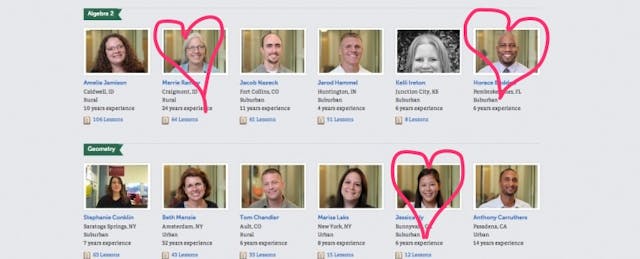Type “geometry lessons for high school” into Google and you’ll get 4 million results. For any teacher, that’s a daunting and basically useless collection. Hours can be wasted looking for the right lesson to fit one’s teaching style. However, if you happened to know Tom Chandler at Highland High School in Colorado, you’d know he likes to present challenges at the beginning of his unit plans that involve building ramps, treasure chests, or google satellites. Or Stephanie Concklin from Saratoga Springs High School in New York, who likes to teach geometry with catchy rhymes like “rockin’ rotations” and “pretty polygons.”
And now lesson-planning site, BetterLesson, aims to help you find not just any old lesson plan, but one that suits your style of teaching.
That’s the core idea behind BetterLesson’s massively redesigned site which went live this week: instead of listing exhaustive collections of individual lessons from different sources, BL is organizing lesson plans by the teachers who created them. Get to know the teachers first, then decide to use their lessons.
The new site not only promises much needed Common Core resources but also aspires to make the search for the “perfect” lesson plan like searching for one’s soul mate. “It’s like e-harmony for teachers. We want to understand who you are as a teacher, and then match you up with the teacher of your dreams,” says cofounder and CEO, Alex Grodd.
Each grade level has lesson plan collections from at least six teachers. A geometry teacher, for instance, searching for Common Core lessons can get to know the various styles of six different Master Teachers--how they teach, how they sequence their units, and what type of student population they work with. Each Master Teacher has a profile which describes a bit about themselves and provides a full year’s worth of lesson plans. “Because we are paying these teachers, and paying them a lot of money,” Grodd says, “we are trying to empower them to capture their special sauce, so each teacher has a shot of finding their soul mate.”
That special sauce is spelled out in each lesson plan. Each lesson describes the goal of the lesson and the lesson procedures with a narrative (both written and captured on video) of the teacher describing exactly how the lesson should be executed. All the resources and materials used for the lesson are also attached. “Most lessons [elsewhere] are written in really idiosyncratic ways, with gaps, holes, or shorthand. Or they are written for compliance,” Grodd says. “We said: ‘What would a lesson look like if it was written for sharing?’ That’s what’s unique about these lessons. It was the first time teachers were writing lessons in a deep way to share with other teachers.”
While the content and format of each lesson might differ, BL’s presentation style--a clean and sleek looking user interface--stays the same. There are drop down menus, multiple columns and embedded videos in each lesson.
The lessons are still a work in progress. Along with describing how other teachers should carry out the lessons, the Master Teachers are expected to add additional self-made videos of themselves teaching selected lessons throughout the year. Beginning in 2014, BL also plans on sending a professional video crew to tape each teacher five times per year to capture their work in action.
As of early 2014, BetterLesson had posted more than 3,000 Common Core lesson plans. The company hopes to multiple the number of plans--growing to as many as 15,000--later this year. “We are trying to create a really easy, safe way to feel supported. We have these amazing teachers who will help you navigate a really practical way to implement Common Core,” says Grodd.
The amazing teachers were recruited throughout 2013. Each teacher is paid $15,000 per year for their work. A portion of the funds and the teachers came from the NEA, who provided $3.6 million for the project. BL also recruited teachers on their own, with the support of the Gates Foundation, who provided $3.5 million.
Teachers will still be able to use the BL site in familiar ways, namely creating their own profile and sharing their own lesson plans. It has also offered school networks, such as KIPP, their own version of BL to share lesson plans across the network. However, along with supporting the new site, the company anticipates shifting its focus toward the professional development market. This means BL is unlikely to create specialized “intranet” versions of its site for groups as it did for KIPP. “As we move forward, we are less fired up about the intranet market and more about the professional development market,” Grodd says.
The Common Core is on, and as schools and teachers continue to look for help in supporting the shift, it won’t be surprising if BL isn’t the only company that shifts its strategy to meet the growing demand.


